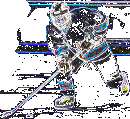When my daughter took to the ice for her very first skate, she promptly fell at the entrance gate. The fall surprised her, as well as (I'm sure) the hardness of the ice. She cried and cried, and didn't have an interest in skating until many years later (when she turned 9).
For this second time, she was a little more game. She was ready to be a beginner ice skater! I gave her two things to think about that enabled her to "feel balanced" on the slippery surface.
Knees Bent
Keep your knees bent! If you're a beginner, this lowers your "center of gravity." When your knees are bent, you establish a "good base" from which to ice skate. When you watch figure skaters or hockey players on television, you'll notice that they rarely skate "standing up", except to glide back to the bench.
Bum Out
This is an extension of the "knees bent" advice, but let's be frank: nine year olds like hearing adults say the word "bum". When I say "bum out", I literally mean stick out your posterior. I exaggerated the motion for my daughter, and her laughing encouraged me. I told her "pretend you're starting to sit down." Her sense of balance on the ice became evident. By having your backside stick out, you enable your upper legs (your thighs) to do "more work", whether it's pushing or gliding. Also, this posture enables a lower center of gravity.
All of ice skating is about finding your balance while standing on two very thin blades of skates. By keeping your knees bent and your bum out (for adults, I'd say "lower your stance"), you'll feel more balanced. Over time, as you get used to gliding and skating in this position, you'll be able to stand straighter. I do promise you that you will fall into this more balanced posture as you attempt more advanced moves on the ice.
Falling Down and Getting Up
You cannot avoid falling while learning to ice skate. Every time you fall, especially in public, think to yourself "well, I figured out something that doesn't work." When you do fall down, as a beginner, make sure that roll over to your front, and get on your hands and knees. Pick up your strong foot, then your second, and then push yourself up to your "sitting posture" from above. Practice getting up like this, so that when you get up you're feeling balanced. As a hockey player, I've noticed many players at public ice skating sessions wearing knee/shin guards and gloves. You might consider this too, especially as you're starting out.
